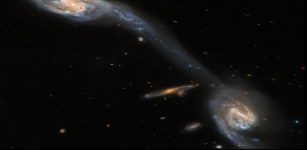Doomed Star Eta Carinae – May Be About To Explode But No One Knows When
Eddie Gonzales Jr. – MessageToEagle.com – Eta Carinae, with a mass 100 times greater than our sun, is a prime candidate for a supernova.
Its explosion is inevitable, but the timing remains uncertain—it could happen anytime between next year and a million years from now.
Credit: NASA, ESA, Hubble; Processing & License: Judy Schmidt
Historical records do show that about 170 years ago, Eta Carinae underwent an unusual outburst that made it one of the brightest stars in the southern sky. Eta Carinae, in the Keyhole Nebula, is the only star currently thought to emit natural LASER light.
This featured image brings out details in the unusual nebula that surrounds this rogue star. Diffraction spikes, caused by the telescope, are visible as bright multi-colored streaks emanating from Eta Carinae’s center.
Two distinct lobes of the Homunculus Nebula encompass the hot central region, while some strange radial streaks are visible in red extending toward the image right. The lobes are filled with lanes of gas and dust which absorb the blue and ultraviolet light emitted near the center. The streaks, however, remain unexplained.
—-
Eta Carinae, a binary star in the Carina constellation, is among our Galaxy’s largest, most massive, and brightest stars. Its main component is a gigantic bright blue variable star, 100-150 times more massive than the Sun.
Eta Carinae: Observations in UV Light Uncover Magnesium Embedded in Warm Gas. Image credit: NASA, ESA, N. Smith (University of Arizona), and J. Morse (BoldlyGo Institute) – Public Domain
This star is highly unstable and could explode as a supernova or even a hypernova (a type of supernova capable of emitting a gamma-ray burst ) at any time. It is located inside a large bright nebula , known as the Carina Nebula , the “Keyhole” , or NGC 3372 .
Eta Carinae’s notable feature is its unpredictable brightness changes. First cataloged by Edmund Halley in 1677 as a fourth-magnitude star, it had significantly brightened by 1730, becoming Carina’s brightest star.
After fading in 1782, Eta Carinae brightened again from 1820, peaking in April 1843 as the second brightest star after Sirius. It reached -0. 8 magnitude despite being 8, 800 light-years away.
Eta Carinae brightened in 1820, peaking in April 1843 as the second brightest star after Sirius. It reached -0. 8 magnitude despite being 8, 800 light-years away.
NASA
Written by Eddie Gonzales Jr. – MessageToEagle.com Staff Writer












